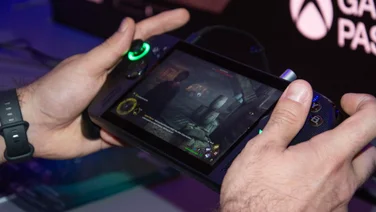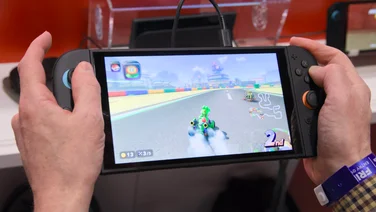To help us provide you with free impartial advice, we may earn a commission if you buy through links on our site. Learn more

Six hours and 42 minutes. That’s how long it took to leisurely play through the Order: 1886. With so much pre-release furore about its playing time, we thought it best to start with that fact.
At around £45 a copy, and with no co-op or competitive multiplayer, that works out at £6.71 an hour for your cover-based shooting action. Not cheap, but peanuts compared to a Megadrive cartridge of Another World back in 1992. That was around £75 (adjusted for inflation) and we whipped through that in about 3 hours and yet never regretted buying it. So the big question is does The Order: 1886 manage to pull off the same trick?
A DIFFERENT ENGINE
In terms of graphical fidelity, you’re certainly getting your money’s worth. Every second of the game is packed with sumptuous-looking assets, from the detailed locales and lifelike characters to some incredible-looking material, particle and lighting effects. It’s truly stunning to behold from beginning to end. Whether looking out over a smoky, bedraggled Whitechapel, beholding Crystal Palace wreathed in flames or fighting your way through luxuriously appointed staterooms.

Set in an alternative 1886, you play as Sir Galahad, a Knight charged with defending the realm from half-breed monsters. The game’s fantastical Victoriana undoubtedly falls into the Steampunk genre. From being a niche genre oddity, it’s grown hugely in popularity in recent years, and games include Bitmap Brother’s Chaos Engine and parts of the Thief series, to the recent Dishonoured and 80 days.
The Order: 1886 can’t claim much in the way of originality then, but it’s undoubtedly the finest looking example of steampunk ever created. In fact, despite a palette that rarely strays from a sepia monotone, The Order: 1886 is arguably the best-looking game to grace any console.

It may look great, but there’s not actually that much of it, due to the developer’s decision to use a 21:9 aspect ratio throughout the game. The letterboxed look is highly cinematic but also has the benefit that there are only 1,920×800 pixels to render. This removes some of the load of the graphics hardware, enabling the game to run with 4X MSAA for a very clean-looking image.
We quite like the cinematic look in cutscenes, but in the firefights that dominate the gameplay having such limited vertical resolution can be a problem. It’s easy to miss the sniper who’s shooting you from a first story window, as you have to look up to see him, even at a distance. Now this could have been fixed with a change in the field of view or a more intelligent camera, but both may have had their downsides.

^ It can be hard to see what’s going on with the narrower than normal field of view obscuring the first-floor windows here
STEAMY ACTION
As well as being visually restricted, the action is spatially limited too. The Order is the most linear game we can remember playing in a long time. There are practically no open areas, and it’s unusual to find a gunfight where you can approach the enemy from more than one angle.
The gunplay itself is good stuff, the weapons bark and hit home with a violent impact, bar the electric-powered gun that snuffs people so rapidly you barely get a chance to appreciate it. Unusually the game’s crosshair flashes red when you get a kill, so you know if your enemy has ducked back or died.
You can carry only one main weapon (plus a pistol), so you will change your tactical approach constantly to match whatever you’re wielding. That said, you could probably get through the whole game with any of the weapons, given enough ammo; as there are rarely situations that require a specific approach, except when you’re equipped with some monstrous gun to butcher a horde of opponents. In this category, we particularly love the Thermite Gun, that spits out clouds of choking white powder, and then ignites them into a firestorm that looks as good as it kills.

Your enemies are a pretty limited bunch, consisting almost entirely of men with various guns. There are some armoured examples, which rush you with shotguns or wield heavy weapons, and some snipers, but for the most part they are the usual stand, duck, shoot kind of stooges found in every game of this ilk. They put up a fair challenge on normal difficulty, but we rarely found ourselves dying in the same firefight twice.
This is partly due to the Blackwater vial that Galahad and every knight of the order carries. It allows you to respawn after a short time if downed by gunfire, unless your enemies close quickly to finish you off. It also provides a nifty bullet-time ability which lets you take out multiple assailants in rapid succession.

(UN)ACTIVITY HOLIDAY
Beyond the firefights, there’s very little else. There’s some basic stealth action, but this is usually done in a win-or-lose manner, with nothing complex like different alert statuses, and guards chasing you around. The main stealth section spreads the guards out, so that they never discover each other’s bodies, and being discovered results in instant death.
You have a good range of clambering skills, but they are never put to the test under any duress or peril. There are basic sections in which you have to jump and climb in order to get to the next gunfight, but the fights and the climbing are never combined, and there’s never any time limit or urgency in these sections. As a result, they feel like merely filler. As do the handful or simplistic environmental puzzles, usually requiring you to push an object before climbing up on it to get somewhere else.

A surprise, though not necessarily a disappointment, is that there are no RPG elements present. it’s amazing just how core levelling, crafting and upgrading have become to gaming, appearing in almost every genre these days. The Order: 1886 doesn’t indulge in any of this, your capabilities are unchanged from the first firefight to the last. Logically it makes sense that an experienced Knight isn’t going to suddenly power-up over the course of a couple of days, but it does make the game feel even more single-paced.
A RIGID ORDER
What you do get are lots of pre-packed action sequences, requiring you to hit the button that flashes up on the screen to continue playing, often know as quick-time events (QTEs). The opening 15 minutes is purely driven by QTEs, with the exception of some staggering at walking pace only down a corridor.
The QTE sequences look great, but they generally fall into two camps. In the first type, if you fail to press the button in time you die, there’s rarely any branching possibilities or routes through these segments. In the other you usually use some kind of steampunk gizmo to open a door, or short circuit a machine, here you can make as many attempts as you want and nothing bad will befall you.

Most disappointing is that one of the big QTE-based battles in the game is repeated practically identically later in the game. There’s also another section, where you fight off the half-breeds, which is repeated twice over. Given the obvious budget of the game, it’s rather disappointing that these sections have been reused. More invention could have been included, without endangering the strict narrative.
A MAN OF CHARACTER
The only thing more rigid than the gameplay, is the titular order’s moral code. They are quite literally the Knights of the Round Table, with links right back to Arthur himself (not a myth in this world). This 19th century version is easiest understood as Victorian Jedi, sobre, celibate and practically immortal thanks to the blackwater, which comes from the Holy Grail itself.
We don’t want to reveal too much of the plot, as it’s by far the best part of the game. The storytelling is adept, little is explained at first, but as you learn more about the characters, their relationships and background, the plot twists ably to draw you in. There’s intrigue and treachery afoot, and the game leaves so much unsaid and uncovered, that its begging for a sequel.

Galahad is a real hero, a man of unwavering devotion to his code of chivalry. He moves, even leaps and climbs, with the restrained decorum of a gentlemen. His dialogue, and everyone else’s, is impeccably delivered. In terms of tone it’s a million miles away from the glib dialogue of Uncharted, but in terms of execution you can tell that some of the developers used to work at Naughty Dog.
With its gameplay held entirely in thrall to its narrative priorities, it’s a huge relief that its story actually delivers. We got to the end and instantly wanted to find out what happened next, which is always the sign of a well plotted game.
CONCLUSION
What we have here is the anti-Diablo, the anti-Destiny, the anti-No Man’s Sky. A game where every single second of action has been hand-crafted. Nothing is emergent, procedurally created, and there’s no expectation for you to play an instant of it twice over. It’s a game with no social features, no grind, no stats and no bragging rights whatsoever.
If you’re cash rich and time poor, which describes many people who own expensive games consoles (although not necessarily those most vocal about them) then The Order: 1886 is a good way to spend seven hours of your busy life. It’s the closest thing we’ve played in ages to an interactive movie. And that’s no bad thing in-and-of itself, this is undoubtedly a satisfying bit of entertainment.
However, as a game it falls well short of the pleasures provided by other in its genre. Both The Last of Us and Tomb Raider are far better games by almost any measure, subjective or objective, with the obvious exception of graphical fidelity. Given the additional power of the PlayStation 4, it wasn’t unreasonable to expect something that felt as dynamic to play as either of those games, and The Order: 1886 simply isn’t.
In terms of variety it doesn’t feel like 12-15 hours of gameplay have been packed into just under seven hours; but rather that the variety of gameplay on offer only barely fills out the running length. It feels as restrained and narrow as Galahad’s strict moral code. But although that rigid nature makes him an excellent character, it makes the The Order: 1886 merely an average game.






